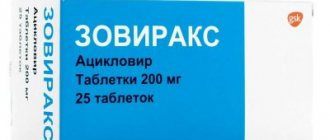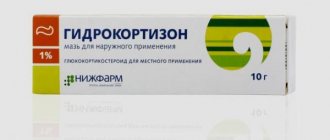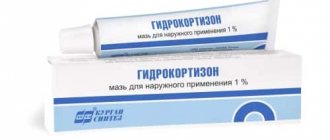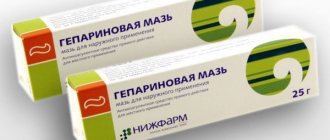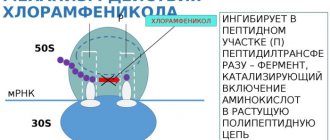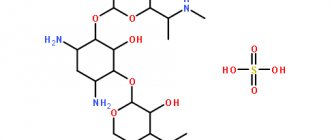Pharmacological properties
Pharmacodynamics
Hydrocortisone acetate is a glucocorticosteroid. When applied topically, it suppresses allergic and inflammatory reactions that occur in the area of the outer membranes of the eye (sclera) and the anterior segment of the organ of vision.
The mechanism of action of the drug, like other corticosteroid drugs, is based on suppressing the function of tissue macrophages and leukocytes. Hydrocortisone acetate limits the migration of mast cells, macrophages and leukocytes to the site of inflammation and inhibits the synthesis of interleukin-1. It stabilizes lysosome membranes, thereby reducing the concentration of proteases in the area of inflammation. Hydrocortisone-POS reduces capillary permeability, which is caused by the release of histamine. The active substance of the drug inhibits the formation of collagen and suppresses the activity of connective tissue cells that synthesize the extracellular matrix (mucopolysaccharides and precursors of collagen and elastin). In addition, hydrocortisone acetate inhibits the enzyme phospholipase A2, which leads to suppression of the synthesis of leukotrienes and prostaglandins.
Pharmacokinetics
Hydrocortisone acetate has lipophilic properties, so it can penetrate through the cornea of the eye into the aqueous humor of the anterior chamber. The degree of penetration of the active substance into the tissue directly depends on the condition of the cornea: in case of damage or inflammation of the mucous membrane of the eye, it increases significantly.
Analogs
If there are contraindications to the use of hydrocortisone eye ointment, you can replace it with other drugs of similar action:
- “Tobrazon” drops - contain hydrocortisone and the antibiotic tobramycin;
- dexamethasone ointment or drops;
- anti-allergic non-hormonal drops “Lecrolin”, “Allergodil”.
Replacing medications with analogues should only be done as prescribed by a doctor. What can replace hydrocortisone ointment depends on the nature of the person’s disease.
Contraindications
Absolute:
- bacterial, fungal or tuberculous eye infection;
- viral eye diseases (including superficial corneal herpes);
- chronic conjunctivitis caused by Chlamydia trachomatis (trachoma);
- damage and disruption of the integrity of the corneal epithelium;
- immunization period;
- age up to 1 year;
- hypersensitivity to individual components of the drug.
With caution and only as prescribed by a doctor, Hydrocortisone-POS 2.5% and 1% eye ointment is used to treat children over 1 year of age, as well as during pregnancy and breastfeeding (provided that the expected therapeutic effect for the mother exceeds the possible threat to the fetus or child).
Precautionary measures
In order for the treatment to be successful and not accompanied by side effects, a number of mandatory measures must be observed :
- never increase the dosage or course of therapy without consulting a doctor;
- Do not use Hydrocortisone ointment on children under one year of age;
- the drug should not be taken if there are ulcerative lesions on the eyelids and wounds;
- since long-term use of the ointment can provoke secondary infectious lesions, it is advisable to carry out treatment while taking antibacterial agents.
Regardless of the age at which the ointment is prescribed to the child, before using Hydrocortisone, it is imperative to consult with your doctor . This will avoid possible allergic reactions, tissue necrosis and withdrawal syndrome.
It is also worth remembering that Hydrocortisone ointment is never used for infectious diseases , including conjunctivitis.
Hydrocortisone-POS, instructions for use: method and dosage
Hydrocortisone-POS ointment 1% and 2.5% is used subconjunctivally. A strip of ointment about 1 cm long is placed behind the lower eyelid 2-3 times a day.
After each application of the drug, it is necessary to close the tube tightly. When applying the ointment, do not touch the tip of the tube to the conjunctiva or the surface of the skin.
If therapy with other eye medications is prescribed simultaneously with the drug, it is recommended to administer Hydrocortisone-POS 15 minutes after instillation of the medications in the form of eye drops.
The course of treatment is usually 2–3 weeks.
Dosage and method of administration
The medicine is intended for topical use only. One centimeter of eye ointment is injected into the conjunctival sac two to three times a day. The course of treatment usually does not exceed two weeks. Its duration may in some cases be increased according to the recommendations of a specialist.
Similar effects
Sometimes the use of hydrocortisone ophthalmic ointment may be accompanied by the development of allergic reactions, burning, scleral injection, and short-term blurred vision.
When using the drug for more than ten days, an increase in intraocular pressure may be observed with the possible development of steroid glaucoma with direct damage to the optic nerve and partial impairment of visual fields.
Subcapsular cataracts and slower wound healing processes may also develop (in diseases that cause significant thinning of the cornea, possibly its perforation (perforation)).
Due to the suppression of the body's defense reactions, prolonged use of the ointment may result in the addition of a secondary bacterial infection. In acute purulent eye diseases, glucocorticosteroids can intensify or mask existing infectious processes. Also, with long-term use of the drug, fungal infection of the cornea may occur.
We recommend another article from this section - “Acyclovir ointment instructions for use”
You can find out for what diseases Tsiprolet eye drops are used, as well as the instructions and price of the drug, from this article.
Overdose
Overdose of hydrocortisone ophthalmic ointment is extremely rare. At the same time, there is an increase in local side effects. When the drug is discontinued, the overdose phenomena disappear on their own.
Side effects
Very rarely, allergic reactions to the drug may occur (contact dermatitis, burning, redness of the sclera, eyelid eczema, dermatoconjunctivitis).
With long-term therapy, the appearance of complicated cataracts and secondary glaucoma is possible, so patients using the ointment for more than 2 weeks, as well as patients with a history of glaucoma, should regularly monitor intraocular pressure.
If adverse reactions occur, the drug should be discontinued and consult an ophthalmologist.
What does hydrocortisone ointment help with: treatment of allergies
The main use of hormonal ointment is to relieve symptoms of an allergic reaction.
. Hydrocortisone ointment for external use is actively used for various allergic inflammations (skin redness, rashes, itching, swelling). Considering the hormonal composition of the ointment, it is worth using it when allergic inflammation is very painful.
Features of treatment:
- The ointment is used for 1-2 weeks. Sometimes the course is extended to 3 weeks. Longer use of a hormonal drug is fraught with addiction. When the ointment is subsequently discontinued, reactions similar to allergic ones occur (swelling, redness, skin inflammation).
- The number of applications per day is 2 or 3 times. The instructions for the ointment emphasize that its excessive frequent application can cause systemic (general, spreading to the entire body) side effects.
- The ointment can be used under a bandage (for adults) and is not recommended for use under a bandage for children. You can leave the bandage with hormonal ointment on for a short time. Otherwise, this is fraught with the penetration of a large amount of hormones into the general bloodstream.
- Treatment with hormonal ointment can be supplemented with antibacterial or antifungal agents if there is a risk of infection of the irritated skin.
special instructions
During treatment with eye ointment, you should not use contact lenses.
Impact on the ability to drive vehicles and complex mechanisms
Immediately after the application of Hydrocortisone-POS, a short-term disturbance in visual acuity may occur, accompanied by a slowdown in the speed of psychomotor reactions. Therefore, the ointment should not be applied if the patient plans to drive vehicles or operate other potentially dangerous mechanisms in the near future.
Side effects
Hydrocortisone ophthalmic ointment 1 percent rarely causes adverse effects when used correctly. Possible side effects:
- burning of the mucous membrane;
- redness of the conjunctiva;
- peeling of the skin of the eyelids.
If any side effect occurs, stop using the medicine and consult a doctor.
special instructions
Any hydrocortisone medications should not be used for more than 14 days without a break. Long-term treatment leads to the development of glaucoma and cataracts. In patients undergoing long-term treatment, intraocular pressure should be measured regularly.
There were no symptoms of overdose when using hydrocortisone ophthalmic ointment. The ointment should not be applied directly to the eyes; it may cause damage to the cornea.
Wearing contact lenses during treatment with hydrocortisone suspension is not recommended. The drug causes short-term visual impairment, so you should be careful when driving or operating machinery.
Reviews of Hydrocortisone-POS
Most reviews about Hydrocortisone-POS are positive. The drug is high quality, effective and fast-acting. The ointment helps with conjunctivitis and other inflammatory eye diseases, quickly relieves swelling, and does not irritate the mucous membrane. The product can be used during pregnancy and breastfeeding, as well as in children over 1 year of age.
Among the disadvantages, users most often note the cost of Hydrocortisone-POS, since it is 2-3 times higher than the cost of similar domestic ointments.
Description of the drug
Hydrocortisone eye ointment is a synthetic glucocorticosteroid drug used externally to treat inflammatory eye diseases.
This remedy has a pronounced anti-inflammatory, decongestant, antipruritic and antiallergic effect.
Hydrocortisone is produced in the form of an ointment (the drug can also be in the form of a gel or cream), which is packaged in tubes of three and five grams.
The main active ingredient is hydrocortisone acetate (glucocorticosteroid). One hundred grams of ointment contains one gram of hydrocortisone. Excipients: methylparaben (nipagin), propyl parahydroxybenzoate, stearic acid, anhydrous lanolin, pentaerythrityl dioleate (pentol), purified water, medical petroleum jelly.
The drug is suitable for local use. To do this, place a strip of ointment (about a centimeter) behind the lower eyelid. The procedure is carried out two to three times a day. The course of treatment lasts from one to two weeks . If necessary, the doctor may continue therapy with Hydrocortisone.
It should be remembered that during treatment you should stop using contact lenses. If eye drops are used in parallel, then at least fifteen minutes should pass between their administration and use of the ointment.
The ointment should be used with extreme caution for glaucoma. It is necessary to constantly monitor eye pressure.
Analog of Hydrocortisone - Maxidex.
The shelf life of Hydrocortisone is two years. It must be stored at a temperature of five to fifteen degrees.
Indications for use
Hydrocortisone ointment 1% is prescribed to patients for the prevention and treatment of inflammatory skin processes caused by physical or chemical exposure. It also has antiallergic and antipruritic effects. The ointment is more effective in patients with acute dermatoses, and has a lesser therapeutic effect in patients with chronic skin diseases. Hydrocortisone is used in cosmetology for acne and fine wrinkles, although this indication is not in the official instructions. According to the annotation, hydrocortisone ointment is indicated for the treatment of:
- infected wounds;
- weeping dermatitis, especially during exacerbation;
- poorly healing wounds that cannot be treated;
- inflammatory processes on the skin;
- autoimmune diseases of non-microbial etiology;
- trophic ulcers;
- burns;
- frostbite.
Hydrocortisone eye ointment
Hydrocortisone for the eyes penetrates poorly into the intraocular fluid through the orbit. The ointment is well absorbed into the epidermis, systemic blood flow and mucosal epithelium. Hydrocortisone acetate has an antimetabolic effect, reduces the severity of the immunological response, inhibits scarring and the formation of connective tissue. According to the instructions, the eye ointment is used for thermal or chemical burns, but only after the cornea has healed. Other uses of the drug:
- allergic pathologies (keratoconjunctivitis, conjunctivitis, eyelid dermatitis, blepharitis);
- after surgery (blepharoplasty and others);
- inflammation of the anterior part of the eye:
- sympathetic ophthalmia.
For wrinkles
Although most doctors have a negative attitude towards this method of rejuvenation, women agree to any methods to restore beauty. Before starting the course, you should consult a dermatologist to avoid side effects. The total duration of use of hydrocortisone ointment for wrinkles should not exceed two weeks. Before using the drug, you need to apply a little to the skin in the elbow area to make sure there is no allergy. If after 20 minutes there is no redness, then you can smear the product on your face, avoiding contact with the mucous membranes of the eyes.
For acne
Not only teenagers, but also adults can experience skin rashes. Acne is often caused by pregnancy, long-term use of medications, or hormonal imbalance. A person at any age will feel insecure if there is acne on their face. Hydrocortisone is an excellent remedy for acne. Judging by the reviews, the problem goes away after the first week of use. The ointment should be applied to cleansed skin, preferably at night.
Analogues of hydrocortisone ointment
Analogues of hydrocortisone ointment based on the same active substance:
- Hyoxysone
- Laticort
- Lokoid
Storage conditions
In a cool place at a temperature not exceeding 15°C. Keep out of the reach of children. Do not use after the expiration date stated on the packaging.
Hydrocortisone ointment is a synthetic glucocorticosteroid drug for external use. This drug is a decongestant, antipruritic and anti-inflammatory agent. It has an inhibitory effect on the release of cytokines (interferon and interleukins) from macrophages and leukocytes. Thus, production is suppressed, the synthesis of prostaglandins and the metabolism of arachidonic acid are disrupted. Stimulation of glucosteroid receptors allows for increased induction of lipocortin formation. Reduces cellular infiltrates of the inflammatory type, reduces the level of migration of leukocytes, as well as lymphocytes to the area of inflammation. When prescribed and taken in recommended doses, it does not cause systematic side effects.
Hydrocortisone ointment - pharmacokinetics
The ointment (after application) tends to accumulate in the epidermis (mainly in the granular layer). Metabolization occurs directly in the epidermis layer, then in the liver. Excretion occurs through the kidneys and intestines.
Hydrocortisone ointment - instructions for use
The ointment is prescribed for skin diseases of an allergic and inflammatory nature of non-microbial etiology, as well as those accompanied by itching. These can be eczema, dermatitis - allergic and contact type. It is also recommended for neurodermatitis, pruritus, psoriasis, insect bites, erythroderma, seborrhea and so on.
Contraindications include hypersensitivity to the base of the drug - hydrocortisone, or to its other components. It is also not recommended for use for wounds and ulcerative lesions of the skin. Including skin diseases of a bacterial, viral and fungal nature. Contraindicated for tuberculosis and syphilitic skin lesions. You should not use this ointment for acne vulgaris, perioral dermatitis, Rosacea, skin tumors, and so on. Hydrocortisone ointment is contraindicated for children under two years of age and pregnant women.
Hydrocortisone ointment should be used with increased caution during lactation, diabetes and tuberculosis. Directions for use and dosage
Directions for use and dosage
Apply a thin layer of ointment to the affected area of skin at least two to three times a day. Depending on the nature of the disease and the effectiveness of therapy, the course of treatment lasts from six to fourteen days. In turn, in case of persistent, severe course of the disease, the course is extended to twenty days. For a more pronounced effect on limited areas, it is possible to use occlusive dressings. For children aged two years or more, it is necessary to limit the treatment period to two weeks. Activities that increase the level of absorption of the steroid, that is, warming, occlusive and fixing dressings, should be excluded.
Hydrocortisone ointment - side effects
With sufficiently long-term use, there is a risk of developing secondary skin lesions of an infectious nature, as well as atrophic changes and hypertrichosis. With prolonged use of occlusive dressings, especially in areas with a large affected area, there is a risk of developing symptoms of hypercortisolism. There is a possibility of developing hyperglycemia, glucosoria, reversible suppression of the functions of the adrenal cortex and other similar manifestations, including Cushing's syndrome. These manifestations occur due to the hormone hydrocortisone. In such cases, it is recommended to gradually discontinue this ointment.
special instructions
The drug is prescribed to children under twelve years of age only under the supervision of a physician. If within seven days of using the drug there is no improvement or the condition worsens, you should stop using the ointment and consult a specialist.
Glucocorticoid hormones in the form of an ointment are in great demand for diseases of the skin and eyes. One of the popular drugs in this group is Hydrocortisone. Not everyone knows whether such a medicine is used in childhood, when its use is justified, and what side effects this drug can cause in a child.
Reviews
Patients positively characterize the drug, noting the rapid onset of the effect and significant relief of the condition. Sometimes eye ointment is used as usual, and good results are also noted.
When used cutaneously, 0.5% eye ointment is inferior in effectiveness to 1% cream and conventional ointments, because it contains half as much hydrocortisone.
Off-label use – heparin ointment for swelling under the eyes.
There is currently no cure for autoimmune diseases
Some patients notice a difference in the effect of cutaneous application of different products containing hydrocortisone:
- Yulia, 25 years old, Nizhny Novgorod: “I have a seasonal allergy to pollen. When I use hydrocortisone ointment, the itching quickly goes away, and my eyes take on a human appearance.”
- Ekaterina, 30, Moscow: “I used Hydrocortisone for an allergy to the cream, which caused inflammation of the eyelids. I felt better within a few minutes after I anointed it, I used it for a couple of days and it all went away.”
- Olga, 27 years old, Voronezh: “My little child was prescribed hydrocortisone eye ointment by a dermatologist for skin allergies, supposedly it is so harmless that it is even suitable for the eyes. She helped us."
Freedom of every breath without allergies!

